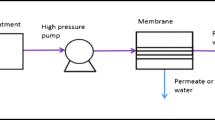Abstract
In the present work, the performance of a small reverse osmosis RO (house scale) desalination unit is experimentally investigated. The influence of test parameters such as salinity of the feed water (2000–3000 ppm), feed water temperature (29–41 °C), and feed flow rate (1.25–1.75 L/min) is considered. The results illustrate that the increase in feed water salinity by about 50% leads to an increase of permeate salinity by about 50%, while permeate flow rate and recovery ratio percent decreases by about 25 and 30%, respectively. Furthermore, for feed salinity less than 2500 ppm, as feed flow rate increases from 1.25 to 1.75 L/min, the salt rejection ratio and permeate flow rate increase from 5 to 7%, respectively, while feed pressure decreased by 16% and recovery ratio percent decreased by 37%. The results demonstrate that increase in feed temperature from 29 to 41 °C leads to an increase in the permeate salinity, while feed pressure and salt rejection ratio percent decrease by about 4 and 6%, respectively. Finally, empirical correlations for permeate salinity, permeate flow rate, feed pressure, recovery ratio percent, and salt rejection ratio percent as functions of feed water flow rate, feed temperature, and feed concentration are obtained.




















Similar content being viewed by others
Abbreviations
- NDP:
-
Net-driving pressure
- RO:
-
Reverse osmosis
- TDS:
-
Total dissolved solids
- PWT:
-
Pelton wheel turbine
- PEX:
-
Pressure exchanger
- TFC:
-
Thin film composite
- BWRO:
-
Brackish water revers osmosis
- ppm:
-
Part per million
- PVC:
-
Polyvinyl chloride
- UDF:
-
Ultrafine depth filtration
- SEC:
-
Specific energy consumption
- p :
-
Pressure
- R :
-
Recovery ratio percent
- SRR:
-
Salt rejection ratio
- T :
-
Temperature
- v :
-
Flow rate
- x :
-
Salt concentration
- E s :
-
Specific energy consumption of the high pressure pump, kWh/m3
- A m :
-
Membrane surface area, m2
- A w :
-
Membrane permeability, L/m2 h bar
- K f :
-
Membrane flow rate factor, L/h bar
- f:
-
Feed
- p:
-
Permeate
- b:
-
Brine
- α :
-
Hydraulic pressure losses factor (α = Pc/Pf)
- ϕ :
-
Concentration polarization (CP) factor
- π :
-
Osmotic pressure, bar
- σ :
-
Membrane reflection coefficient
References
Greenlee LF, Lawler DF, Freeman BD, Marrot B, Moulin P (2009) Reverse osmosis desalination: water sources, technology, and today’s challenges. Water Res 43:2317–2348
Abbas A, Al-Bastaki N (2005) Modeling of an RO water desalination unit using neural networks. Chem Eng J 114:139–143
Al-Bastaki NM, Abbas A (1999) Modeling an industrial reverse osmosis unit. Desalination 126:33–39
Al-Bastaki NM, Abbas A (2000) Predicting the performance of RO membranes. Desalination 132:181–187
Lu Y-Y, Hu Y-D, Xu D-M, Wu L-Y (2006) Optimum design of reverse osmosis seawater desalination system considering membrane cleaning and replacing. J Membr Sci 282:7–13
Lu Y-Y, Hu Y-D, Zhang X-L, Wu L-Y, Liu Q-Z (2007) Optimum design of reverse osmosis system under different feed concentration and product specification. J Membr Sci 287:219–229
Kurihara M, Yamamura H, Nakanishi T, Jinno S (2001) Operation and reliability of very high-recovery seawater desalination technologies by brine conversion two-stage RO desalination system. Desalination 138:191–199
Djebedjian B, Gad H, Khaled I, Rayan MA (2006) An experimental investigation on the operating parameters affecting the performance of reverse osmosis desalination system. In: Proceedings of IWTC10, pp 703–715
Goosen MF, Sablani SS, Al-Maskari SS, Al-Belushi RH, Wilf M (2002) Effect of feed temperature on permeate flux and mass transfer coefficient in spiral-wound reverse osmosis systems. Desalination 144:367–372
Mattaraj S, Phimpha W, Hongthong P, Jiraratananon R (2010) Effect of operating conditions and solution chemistry on model parameters in crossflow reverse osmosis of natural organic matter. Desalination 253:38–45
Yuan W, Zydney AL (1999) Effects of solution environment on humic acid fouling during microfiltration. Desalination 122:63–76
Cho J, Amy G, Pellegrino J (1999) Membrane filtration of natural organic matter: initial comparison of rejection and flux decline characteristics with ultrafiltration and nanofiltration membranes. Water Res 33:2517–2526
Kilduff JE, Mattaraj S, Belfort G (2004) Flux decline during nanofiltration of naturally-occurring dissolved organic matter: effects of osmotic pressure, membrane permeability, and cake formation. J Membr Sci 239:39–53
Ruiz-García A, Nuez I (2016) Long-term performance decline in a brackish water reverse osmosis desalination plant. Predictive model for the water permeability coefficient. Desalination 397:101–107
Kotb H, Amer E, Ibrahim K (2015) Effect of operating conditions on salt concentration at the wall of RO membrane. Desalination 357:246–258
Atab MS, Smallbone A, Roskilly A (2016) An operational and economic study of a reverse osmosis desalination system for potable water and land irrigation. Desalination 397:174–184
Sharif AO, Merdaw AA, Al-Bahadili H, Al-Taee A, Al-Aibi S, Rahal Z et al (2009) A new theoretical approach to estimate the specific energy consumption of reverse osmosis and other pressure-driven liquid-phase membrane processes. Desalination Water Treat 3:111–119
Merdaw A, Sharif A, Derwish G (2010) Water permeability in polymeric membranes, Part II. Desalination 257:184–194
Haluch V, Zanoelo EF, Hermes CJ (2017) Experimental evaluation and semi-empirical modeling of a small-capacity reverse osmosis desalination unit. Chem Eng Res Des 122:243–253
Gupta VK, Hwang S-T, Krantz WB, Greenberg AR (2007) Characterization of nanofiltration and reverse osmosis membrane performance for aqueous salt solutions using irreversible thermodynamics. Desalination 208:1–18
Spiegler K, Kedem O (1966) Thermodynamics of hyperfiltration (reverse osmosis): criteria for efficient membranes. Desalination 1:311–326
Author information
Authors and Affiliations
Corresponding author
Additional information
Technical Editor: Jader Barbosa Jr.
Rights and permissions
About this article
Cite this article
Elsayed, M., Refaey, H.A., Abdellatif, O.E. et al. Experimental investigation on the performance of a small reverse osmosis unit. J Braz. Soc. Mech. Sci. Eng. 40, 218 (2018). https://doi.org/10.1007/s40430-018-1143-3
Received:
Accepted:
Published:
DOI: https://doi.org/10.1007/s40430-018-1143-3




